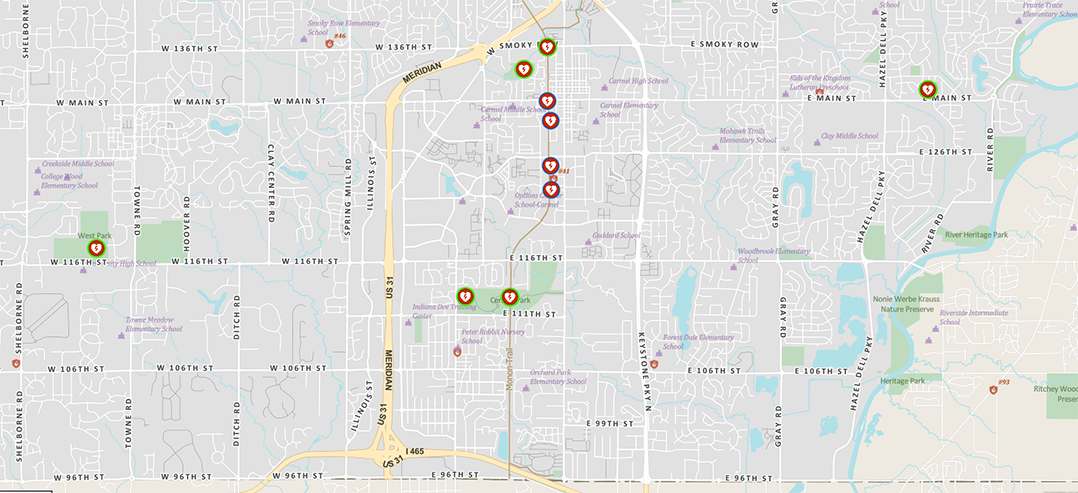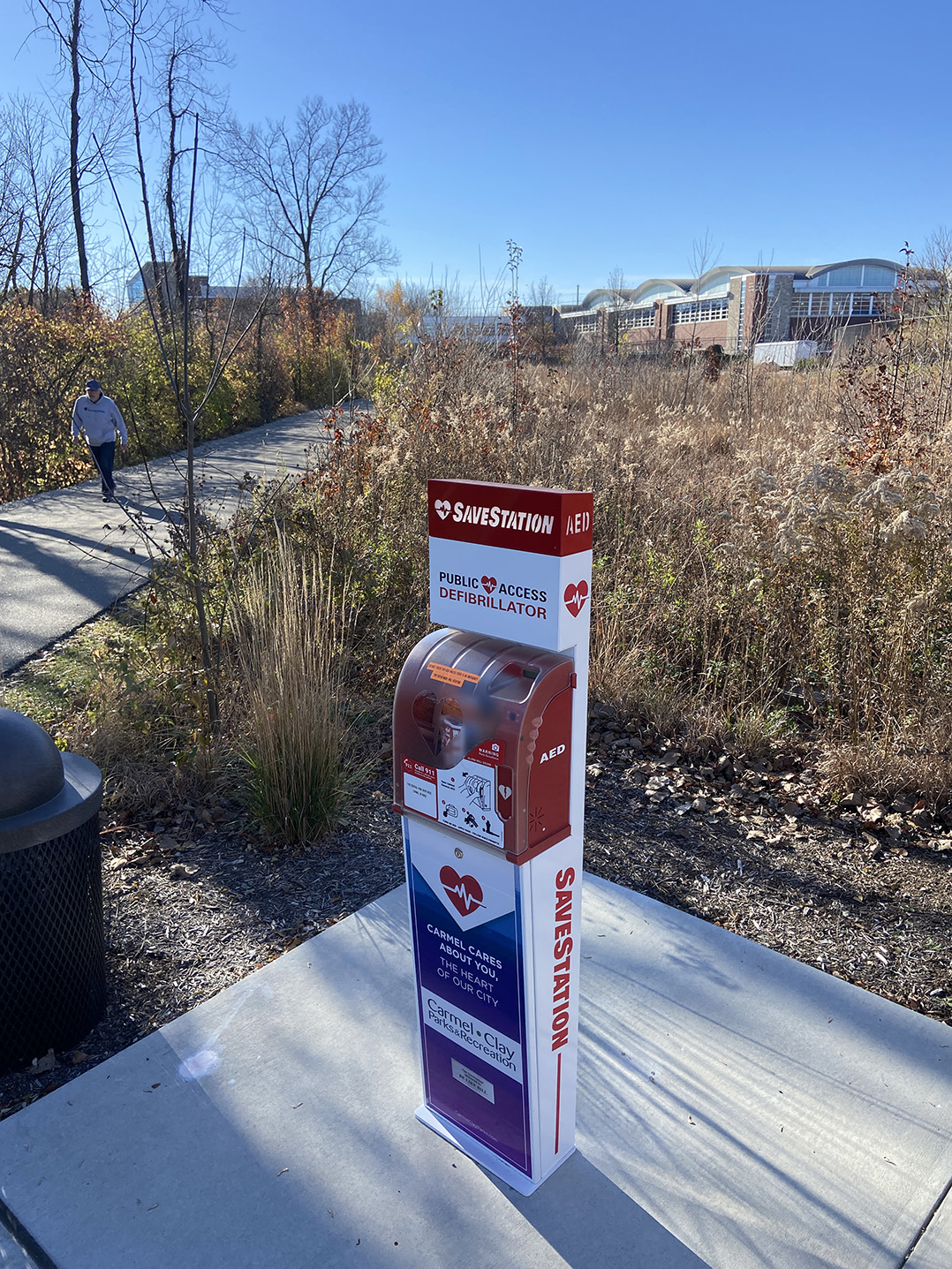In recent years, AEDs have been installed in several busy public spaces around Carmel, and more are on the way.
The SaveStations, which contain an automated external defibrillator and bleeding control kit, can be found along the Monon Greenway and in several parks.
Using an AED may sound intimidating to those without medical training, but they are designed to walk users through every step of the process. Once the AED is opened, it provides audible instructions that could help save a life, according to Andrew Young, Carmel Fire Department EMS division chief.
“From a basic standpoint, if you see somebody collapse, you get the AED out of the cabinet and the AED does all the work for you,” Young said. “All you need to really know how to do is open it up.”

The following explains what to expect when using a SaveStation AED in Carmel. If multiple people are nearby, some steps – such as fetching the AED, calling 911 and beginning chest compressions – can begin concurrently.
- Confirm the person is unconscious by gently shaking him or her and asking, “Can you hear me?”
- If the person is unresponsive, open the SaveStation and remove the AED. The SaveStations are designed to alert first responders when opened, but 911 should still be called to report the emergency.
- Begin CPR chest compressions by pressing repeatedly and firmly with the heel of one hand (and the other hand on top of it) on the center of the chest near the heart. The beat of the song “Stayin’ Alive” is the approximate speed compressions should be done.
- Remove all clothing from the patient’s chest before placing the AED pads.
- Place the pads on the patient as instructed by the AED or as depicted by the defibrillation pads.
- Once the pads are in place, the AED will analyze the heart rhythm. Do not touch the patient during this process.
- If the AED determines a shock is needed, follow the instructions to deliver the shock. For example, it may announce, “Everyone clear. Press flashing button.” Ensure no one is touching the patient before pressing the button to deliver the shock.
- Once the shock is delivered, the AED will instruct CPR to continue and will provide a beat for compressions.
- Two minutes later, the AED will restart the cycle of analyzing the heart, providing a shock if needed and continuing CPR. This cycle can be continued until first responders arrive or until the patient becomes responsive.
- Remain on scene to provide additional information to first responders.

Proactive preparedness
In addition to placing AEDs throughout the community, the City of Carmel has recently begun offering classes to teach the public lifesaving skills.
The HeartSaver CPR course is designed for the general public and provides information on adult and child CPR, AED use and choking relief. Certification lasts two years upon successful completion of the course.
The BLS CPR course is for health care workers and offers more detailed information than the HeartSaver CPR program. Certification lasts for two years.
Learn more about both programs and register at carmel.in.gov/government/departments-services/fire/forms-applications-and-surveys/cpr-public-education-request.
After learning CPR and how to use an AED, Carmel Fire Department EMS Division Chief Andrew Young encourages members of the public to download PulsePoint, a free app that alerts users when someone is in need of CPR within a certain radius.
The app is notified when dispatchers receive a qualifying medical emergency call. Then, the app notifies its users who are near enough to help, as they may be able to reach the scene and begin CPR more quickly than first responders. The app also shows where the nearest registered AED is located.
It’s important to begin CPR as quickly as possible, Young said, because every minute that a patient’s heart is not beating and CPR is not being performed, his or her chance of survival drops 10 percent.
“We can show up as a fire department with expensive fire trucks, multiple personnel, equipment, drugs, you name it,” Young said. “But if nobody has helped the patient before we got there, statistically the chance of survival is working against them.”
Learn more about PulsePoint at PulsePoint.org.

Where are the SaveStations?
The installation of the SaveStations is a joint effort of the City of Carmel and Carmel Clay Parks & Recreation.
SaveStations are at:
- Monon Greenway and Smoky Row
- Monon Greenway and Main Street
- Midtown Plaza
- Monon Greenway at Carter Green
- Monon Greenway and Gradle Drive
- Monon Greenway Central Park Trailhead
- Meadowlark Park
- Westermeier Commons in Central Park
- West Park
- Inlow Park
CCPR and the City of Carmel are looking to install additional kiosks in every CCPR park and other locations along the Monon Greenway. Donors have included Be Like Bill, IU Health North, Bolt for the Heart and Dr. Tim and Denise Hannon. Anyone interested in financially supporting expansion of the program is encouraged to contact Kari Berger, CCPR resource development coordinator, at [email protected].
Bolt for the Heart 5K
The 12th annual Bolt for the Heart 5K will return to Carmel on Thanksgiving morning. The event begins at 9 a.m. Nov. 23 on 3rd Ave. SW just west of the Palladium.
Bolt for the Heart has placed more than 3,000 AEDs throughout the state and works to educate the public about the importance of AEDs. Funds raised through the 5K will help the nonprofit continue these efforts.
Learn more and register for the 5K at BoltForTheHeart.com.



